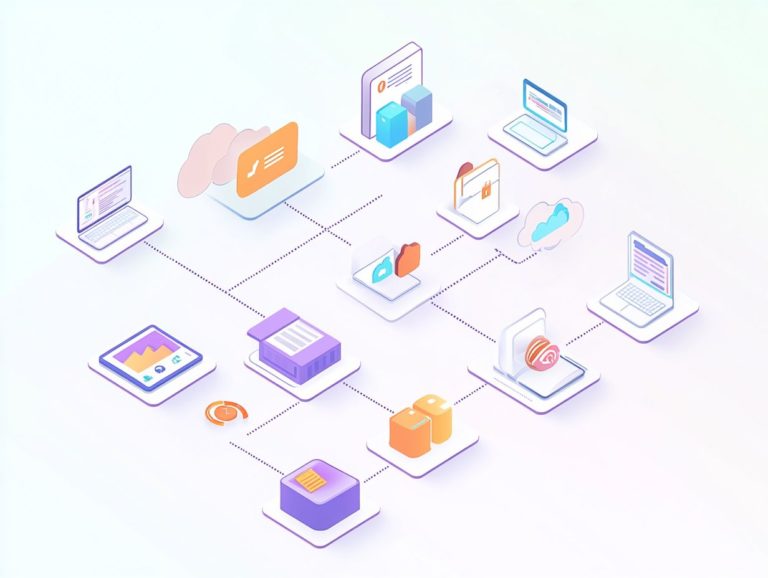How to Create a CRM Communication Plan
In today s fast-paced business landscape, a well-structured Customer Relationship Management (CRM) Communication Plan can truly transform your approach to building strong customer relationships and enhancing communication efficiency.
This article delves into the essence of a CRM Communication Plan, highlighting its numerous benefits and the important parts that contribute to its effectiveness.
You ll find a step-by-step guide to crafting your own plan, complete with best practices for both implementation and evaluation.
By the end, you ll be equipped with powerful tools to elevate your customer interactions to new heights.
Contents
- Key Takeaways:
- Benefits of Having a CRM Communication Plan
- Key Components of a CRM Communication Plan
- Creating a CRM Communication Plan
- Implementing and Evaluating the Plan
- Frequently Asked Questions
- What is a CRM Communication Plan?
- Why is it important to have a CRM Communication Plan?
- How do I start creating a CRM Communication Plan?
- What elements should be included in a CRM Communication Plan?
- How often should a CRM Communication Plan be reviewed and updated?
- What are some best practices for creating a successful CRM Communication Plan?
Key Takeaways:

- A CRM Communication Plan helps improve customer relationships and streamlines communication processes.
- Important parts include identifying your target audience and communication channels.
- Developing a content strategy and messaging is essential.
- Creating and implementing a CRM Communication Plan should be done step-by-step, with regular evaluation and adjustments for success.
What is a CRM Communication Plan?
A CRM Communication Plan serves as a strategic framework designed to elevate your customer relationship management (CRM) game.
It outlines how your organization will engage with customers across various touchpoints, ultimately supporting your business goals while enhancing the customer experience.
By integrating customer data and insights, you can deliver personalized experiences throughout the customer journey.
This approach ensures that you effectively meet customer needs and cultivate strong interactions.
Recognizing the importance of this plan lies in its ability to break down communication into phases that align with key stages of the customer journey, from awareness to retention.
With the power of advanced CRM software, you can collect and analyze data, enabling you to tailor your messaging at each stage and significantly enhance engagement.
This thoughtful approach ensures that your customers receive relevant information when they re most receptive, leading to improved satisfaction and loyalty.
By utilizing analytics derived from customer interactions, you can refine your strategies over time, creating a feedback loop that can significantly boost conversion rates and foster long-term relationships.
Benefits of Having a CRM Communication Plan
Implementing a CRM Communication Plan offers a wealth of benefits that can elevate customer satisfaction, enhance engagement, and ultimately drive sales growth. To maximize these advantages, understanding how to develop a CRM data strategy is essential for fostering customer retention.
By establishing structured communication strategies, you position your organization to gain deeper insights into customer needs and preferences.
This approach ensures that your interactions are not only consistent but also meaningful across various channels.
With effective CRM strategies in place, you create a loyal customer base.
Satisfied clients are far less likely to switch to competitors, ultimately leading to higher retention rates and sustained revenue growth.
Improved Customer Relationships
A well-structured CRM Communication Plan enhances your customer relationships by enabling you to gather valuable feedback and analyze customer behaviors.
This strategic approach allows you to tailor interactions that elevate the overall experience throughout the sales pipeline.
By leveraging various communication channels like email for personalized updates, social media for real-time interaction, and chatbots for instant support you can cultivate a sense of connection and reliability.
Integrating these platforms not only streamlines your communication but also builds trust, encouraging customers to return.
Streamlined Communication Processes
Streamlined communication processes become a significant advantage when you implement a Customer Relationship Management (CRM) Communication Plan. This approach allows you to harness new tools, fostering efficient interactions with customers across various channels.
By integrating these new tools, you can greatly enhance your communication workflows, ensuring that inquiries are addressed promptly and accurately. Automation tools let your team create set answers for common customer queries, greatly reducing response times and freeing up staff to tackle more intricate issues.
This not only enhances overall customer satisfaction but also strengthens brand loyalty. Using the analytics features embedded within your CRM software provides you with valuable insights into customer behavior, enabling you to create proactive strategies that fit individual needs.
This helps you build meaningful relationships while maximizing productivity and efficiency.
Key Components of a CRM Communication Plan

A comprehensive CRM Communication Plan encompasses several essential components that collaborate seamlessly to guarantee effective communication with your target audience. This includes clearly defined messaging and a robust content strategy meticulously tailored to address customer needs and preferences, as outlined in how to develop a CRM training plan.
Target Audience and Communication Channels
Identifying your target audience and selecting the right communication channels are vital steps in crafting a successful CRM Communication Plan. These elements dictate how effectively you can engage with your customers and enhance those all-important interactions through platforms like social media, email marketing, and live chat.
Understanding demographics and behaviors enables you to create personalized messages that truly resonate with your audience. By analyzing key factors such as age, location, and purchase history, you can tailor your outreach strategies, maximizing response rates and bolstering customer loyalty.
For example, younger customers might prefer instant communication via social media, while older generations may lean toward email updates. By recognizing these preferences, you can navigate your engagement strategies with finesse, ensuring that each message is relevant and delivered through the most effective channel. This ultimately cultivates stronger, more meaningful customer relationships.
Content Strategy and Messaging
A well-defined content strategy and messaging framework are essential for your CRM Communication Plan. They enable you to effectively address customer needs, deliver personalized experiences, and support marketing campaigns that resonate with your audience.
To create a successful content strategy, start by analyzing customer preferences and behaviors. Dive into data analytics to uncover insights about what your customers value, their interests, and how they interact with your brand.
By grasping these elements, you can craft a tailored approach that allows you to develop targeted messaging speaking directly to individual segments. Personalized messaging not only enhances customer satisfaction but also cultivates loyalty; after all, people are far more likely to engage with content that feels relevant and meaningful to them.
Continuously refining this strategy based on feedback and shifting behaviors will enable you to adapt your communication efforts, ensuring they remain effective in an ever-evolving market.
Creating a CRM Communication Plan
Developing a CRM Communication Plan requires a meticulous, step-by-step strategy that weaves together CRM implementation methods, highlights essential customer touchpoints, and aligns with the broader customer journey. For a more comprehensive approach, consider learning how to develop a CRM maintenance plan to ensure your communication is effective and perfectly aligned to achieve your business objectives.
Step-by-Step Guide
A step-by-step guide for creating a CRM Communication Plan is vital for businesses aiming to enhance their CRM strategy. For those interested, learning how to create a CRM success plan can align your communication efforts with business goals and ensure effective customer interactions.
Breaking the process into manageable steps streamlines your efforts. This maximizes your investment in customer relationship management and strengthens your bond with clients.
First, define clear objectives that reflect your business goals. This clarity helps tailor your messaging effectively.
Next, assess your current customer data and communication practices. This reveals insights that allow you to segment your audience and personalize outreach, fostering stronger connections.
As your plan progresses, incorporate feedback loops for continuous improvement. This ensures your strategies remain agile and responsive to customer needs.
Implementing and Evaluating the Plan
Implementing and evaluating your CRM Communication Plan is essential. This process helps refine your strategies based on customer insights and best practices.
Engaging actively in this process positions your business for success in a dynamic market.
Best Practices for Implementation
Adopting best practices for your CRM Communication Plan is key. It ensures user adoption and enhances customer communication across all channels.
Prioritize comprehensive training sessions to equip employees with necessary CRM skills. This helps everyone use the system effectively.
Maintain open communication among team members. This allows for feedback and addresses concerns during implementation.
Seamless technology integration is also vital. Leveraging tools that complement your CRM can streamline processes.
By following these best practices, you foster a culture of collaboration and confidence. This ensures your customer relationship management investments yield strong results.
Measuring Success and Making Adjustments
Measuring the success of your CRM Communication Plan is crucial for ongoing improvement. Leveraging customer feedback and data analysis helps refine your strategies.
Implement various methods and metrics focused on customer satisfaction. Tools like surveys, Net Promoter Score (NPS), and social media analytics provide insights into customer experiences.
Analyzing this data helps identify trends and assess communication effectiveness. Use dashboards to visualize metrics and make informed decisions.
Frequently Asked Questions
What is a CRM Communication Plan?
A CRM Communication Plan is a documented strategy for how a business communicates with customers through channels like email, social media, and phone calls. It outlines goals, target audiences, and messaging for each channel, as well as crucial steps like how to create a CRM implementation timeline.
Why is it important to have a CRM Communication Plan?
A CRM Communication Plan ensures all customer interactions are consistent and aligned with business goals. It helps organizations stay organized and engage effectively across channels.
How do I start creating a CRM Communication Plan?
Start by identifying your target audience and understanding their needs. This helps you choose the right channels and messaging for effective outreach.
What elements should be included in a CRM Communication Plan?
A CRM Communication Plan needs key elements. These include clear goals, a defined target audience, effective communication channels, and messaging guidelines.
Don’t forget to add a timeline for implementation and ways to measure success. This helps ensure your plan is effective.
How often should a CRM Communication Plan be reviewed and updated?
Regular reviews of your CRM Communication Plan are crucial. Update it whenever your business goals, audience, or channels change.
Make it a habit to review the plan at least once a year. This keeps it relevant and effective.
What are some best practices for creating a successful CRM Communication Plan?
Start by clearly defining your goals. Understand your audience and segment them for better targeting.
Use a mix of communication channels to reach them. Create messages that are personalized and relevant.
Finally, regularly check your results. This helps you make necessary improvements and ensures success.








